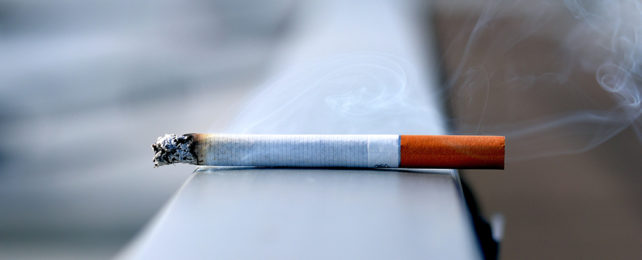You're most likely already aware of the risks of smoking, and of inhaling someone else's 'second-hand' smoke. It's becoming clear that dangers also extend to incinerated particles of tobacco that settle on surfaces – what's dubbed third-hand smoke.
Though the health effects of third-hand smoke exposure have only recently received attention from researchers, studies have indicated these residues can remain on smoke-exposed clothes for months to years, potentially to return to the air where it can linger, especially in indoor environments.
Animal testing suggests there's cause for concern over these persistent pollutants. Now, a small new study involving 10 people has found that tobacco smoke residues on clothing could elevate biomarkers associated with inflammation, mimicking the mechanisms of skin diseases.
Though none of the volunteers developed skin diseases such as contact dermatitis and psoriasis, the team behind the new study says that the harm done to the skin might well lead to health problems further down the line.
"Our third-hand smoke exposures were brief, did not cause skin irritation, and were unlikely to induce skin disease, nevertheless markers associated with early-stage activation of contact dermatitis, psoriasis and other skin conditions were elevated," the researchers write in their report.
The researchers studied 10 healthy non-smokers aged between 22 and 45 years old, who were each asked to wear clothing affected by third-hand smoke for three hours. They were also asked to spend 15 minutes on a treadmill each hour, so that more third-hand smoke particles would be taken up through the skin via perspiration.
After taking blood and urine samples, the team found that biomarkers indicating oxidative damage to DNA were elevated. Changes in blood proteins levels were also detected. What's more, the changes persisted up to 22 hours after exposure. No such changes were observed when the same 10 participants had worn clean clothing for the exercise, in another testing session.
The results suggest exposure to third-hand smoke echoes the kind of damage and activation of immune responses measured in cigarette smokers, the researchers report.
While none of the study participants showed changes in their skin or health, the early indicators are there and need further research – so far only very few studies have been done on how humans respond to third-hand smoke exposure, and none on exposure through the skin.
"There is a general lack of knowledge of human health responses to third-hand smoke exposure," says cell biologist Prue Talbot, from the University of California, Riverside.
"If you buy a used car previously owned by a smoker, you are putting yourself at some health risk. If you go to a casino that allows smoking, you are exposing your skin to third-hand smoke. The same applies to staying in a hotel room that was previously occupied by a smoker."
The researchers propose the skin might be at the greatest risk from third-hand smoke exposure because it's the largest organ we have – it's difficult to protect every part of our bodies from the surfaces and the air that we come into contact with.
Next, the researchers are hoping to conduct studies involving larger groups of people over a longer period of time, and they also want to examine the effects that electronic cigarettes have over the surrounding environment and population.
In the meantime, the findings from this study should be helpful in adding to the existing evidence around the dangers of third-hand smoke, making people aware of the risks and working towards ways of mitigating it.
"Our findings can help physicians in diagnosing patients exposed to third-hand smoke and help develop regulatory policies dealing with remediation of indoor environments contaminated with third-hand smoke," says biologist Shane Sakamaki-Ching, who led the study while at UC Riverside.
The research has been published in eBioMedicine.
